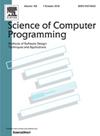将行为语义分析集成到基于使用的移动应用等效测试生成中
IF 1.4
4区 计算机科学
Q3 COMPUTER SCIENCE, SOFTWARE ENGINEERING
引用次数: 0
摘要
图形用户界面(GUI)测试对于确保移动应用程序(app)的预期行为至关重要。新兴的基于使用的自动化测试旨在生成针对应用程序功能特性的模拟人类交互。然而,理解UI语义的困难,以及多种实现选择,极大地限制了执行指定用法的能力。在本文中,我们提出了GUEST(生成基于使用的等效测试),它可以自动生成GUI使用的多个等效测试,以帮助开发人员更彻底地测试移动应用程序的功能。GUEST将来自状态页的文本信息与UI结构集成在一起,用语义信息表达可操作的GUI小部件。它利用状态机编码的状态转换图中边缘链接的语义覆盖来匹配当前状态页面的规范屏幕。为了利用行为语义,GUEST将状态转换图视为一个社交网络,并执行中心性分析,以识别状态转换图中的关键规范屏幕。通过利用关键屏幕和候选小部件可访问屏幕之间的亲密关系,GUEST为经常使用和更容易访问的操作授予更高的优先级。我们在22个流行的应用程序中评估了GUEST的期望用法,结果显示GUEST可以在88%的测试中成功地实现期望的用法,并且在屏幕和小部件分类性能方面都优于最先进的基线方法。本文章由计算机程序翻译,如有差异,请以英文原文为准。
Integrating behavioral semantic analysis in usage-based equivalent tests generation for mobile applications
Graphical user interface (GUI) testing is crucial to ensure the expected behaviors of mobile applications (apps). The burgeoning automated usage-based testing seeks to generate simulated human interactions tailored to functional features of apps. However, the difficulties in understanding UI semantics, along with the multiple implementation alternatives, significantly restrict the ability to exercise a specified usage. In this paper, we propose GUEST (Generating Usage-based Equivalent TeSTs), which automates the generation of multiple equivalent tests for GUI usage to help developers more thoroughly test mobile apps' features. GUEST integrates textual information from state pages with the UI structure to express operational GUI widgets with semantic information. It leverages the semantic coverage of edge links within the state transition graph of state-machine encoding for the usage to match canonical screens for the current state page. To exploit behavioral semantics, GUEST treats the state transition graph as a social network and performs centrality analysis to identify key canonical screens in the state transition graph. By utilizing the intimacy between key screens and candidate widgets' reachable screens, GUEST grants higher priority to frequently used and more accessible actions. We evaluate GUEST on desired usages across 22 popular apps and the results reveal that GUEST can successfully exercise the desired usage in 88% of the tests and outperform the state-of-the-art baseline method in both screen and widget classification performance.
求助全文
通过发布文献求助,成功后即可免费获取论文全文。
去求助
来源期刊

Science of Computer Programming
工程技术-计算机:软件工程
CiteScore
3.80
自引率
0.00%
发文量
76
审稿时长
67 days
期刊介绍:
Science of Computer Programming is dedicated to the distribution of research results in the areas of software systems development, use and maintenance, including the software aspects of hardware design.
The journal has a wide scope ranging from the many facets of methodological foundations to the details of technical issues andthe aspects of industrial practice.
The subjects of interest to SCP cover the entire spectrum of methods for the entire life cycle of software systems, including
• Requirements, specification, design, validation, verification, coding, testing, maintenance, metrics and renovation of software;
• Design, implementation and evaluation of programming languages;
• Programming environments, development tools, visualisation and animation;
• Management of the development process;
• Human factors in software, software for social interaction, software for social computing;
• Cyber physical systems, and software for the interaction between the physical and the machine;
• Software aspects of infrastructure services, system administration, and network management.
 求助内容:
求助内容: 应助结果提醒方式:
应助结果提醒方式:


